facebook.com/FullerHouseNetflix
Netflix released the first season of“Fuller House” on Friday.
“Fuller House,” directed by Jeff Franklin, is the long awaited sequel series to “Full House.” It promised to provide a fun rush of nostalgia and to display the new adventures of the characters of the original series. It made improvements to the original series, and tried to add a few new elements to freshen up the series; but it accomplishes neither.
The sitcom “Full House” developed a large following during its run from 1987-1995. Its impact didn’t end there, however. Despite being recognized in recent years for being a tad too corny, as a product of its time, many people still hold nostalgic fondness for it. After discussion of a potential sequel series for quite a long time, John Stamos (who played Jesse Katsopolis in the original and has ownership stake of the series) announced in April 2015 that “Fuller House” was officially given the green light. It premiered on Friday in a 13-episode bundle on Netflix, and many fans of the original tuned in for the series they had been anticipating for nearly 20 years.
Unfortunately, it was not worth the wait. The series has been met with abysmal reviews from both fans of the original and non-fans. While it can be said that there have been much worse sitcoms, along with sequels to shows in general, this series really only appeals to anyone with very low expectations.
“Fuller House” takes place 20 years after the original series. Danny, Jesse, Becky, Joey and Danny’s new wife Teri are spending their last days in the family home before it’s sold and they go their separate ways. DJ is now a widowed mother of three boys (Jackson, Max and Tommy), and has a career as a full-time veterinarian, who struggles to keep it all balanced. Because of this, Stephanie decides to move in with DJ to help raise her children. In addition, Kimmy, who is now recently divorced and has a daughter named Ramona, decides to move in with her as well.
They end up receiving the house and the series follows the women as well as their children’s shenanigans.
If the plot sounds very similar to the synopsis of the original, that already describes the first problem. It’s simply a repeat of the original: recently-widowed parent has family move in to help them, and they have various misadventures together as their house grows. Many of the episodes copy former episodes, ideas, jokes and overall morals of the original. For instance, “Moving Day” duplicates the plot of the original pilot where Jackson is forced to share a room with Max and he decides to run away because of it (in the original pilot DJ is forced to share a room with Stephanie and moves out for the same reason). They only continue to repeat from there on out, not just overusing “Full House” clichés but sitcom clichés in general.
However, the problem isn’t even that it’s simply the original series all over again; it’s that it wants to be nostalgic for fans but unfortunately it mistakes nostalgia for either repeating ineffective, tired clichés from both “Full House” and sitcoms in general or exact plot points from the show, invariably needing to point out how certain moments in the show happened and how it feels like it’s happening again. It makes it feel like an overly long, unfunny “Saturday Night Live” sketch than it does an actual sitcom.
A running gag in the show is displaying how the characters are adjusting to the world of 2016, along with constantly throwing out as many references to it as they can, and it’s just as annoying as it sounds. It can be argued that the original series referenced pop culture and topics only relevant to the 80s-90s a bit too much, but it felt much more balanced then. Here, there needs to be constant jokes about how they use social media, how they’re adjusting to the fact that iPhones exist, hammering in random reference after random reference-it almost makes you wonder if they had to be literally transported from the 90s to now.
As far as positive elements about the show go, the classic characters thankfully do feel familiar and none of them feel like they have changed for the worst (if they’ve changed at all, that is). It especially helps that the actors are really trying with what little material they’re given; the strongest performances coming from Stamos, Andrea Barber (Kimmy)and Dave Coulier (Joey). The new characters aren’t unwatchable either, even if they could be more interesting, and the child actors are clearly trying.
Despite how the scripts consist mainly of references and copycat writing, it can’t be said that the show’s necessarily awful. It’s annoying, but it doesn’t reach the absolute level of disaster that many bad sitcoms hold.
Overall, “Fuller House,” while certainly not the worst sequel series, has a poor understanding of how to create a nostalgia trip and/or an improvement upon the original show. It doesn’t help that it’s ridden with tired sitcom clichés and references that make it even more topical.
However, it’s generally not as offensive as it could’ve been. If one is looking for a simple, basic sitcom and they don’t mind that it’s been done before,“Fuller House” may find a bit of an audience. Perhaps it’ll improve as time goes on and fix what the first season did wrong. It all depends on whether this will actually appeal to enough people to get that second season and whether people decide if the sequel to “Full House” was worth the wait.



































